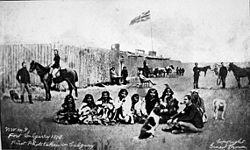Fort Calgary
| Fort Calgary | |
|---|---|

North-West Mounted Police, Fort Calgary, 1878
|
|
| Etymology | Calgary House, a castle at Calgary Bay on the Isle of Mull, Scotland |
| Location | At the confluence of the Bow and Elbow rivers, Calgary, Alberta, Canada |
| Coordinates | 51°02′43″N 114°02′44″W / 51.04528°N 114.04556°WCoordinates: 51°02′43″N 114°02′44″W / 51.04528°N 114.04556°W |
| Area | 2.64 km2 (1.02 sq mi) |
| Founded | 1875 (used until 1914) |
| Built | 1875 |
| Original use | Fort |
| Architectural style(s) | Pine and Spruce logs |
| Website | Official website |
Fort Calgary was established in 1875 as Fort Brisebois by the North-West Mounted Police, located at the confluence of the Bow and Elbow rivers in what is now Calgary, Alberta. The site was purchased by the City of Calgary in 1974 and reopened in 1978 as a historic site and museum.
The construction of the fort was initiated on April 10, 1875 by a federal order to force out whiskey traders from the area. Commanded by Éphrem A. Brisebois, "F" Troop travelled north from Fort Macleod to find a suitable spot on the Bow for the fort. On arrival at the location they made a makeshift boat with a wagon box and tarpaulins to cross the Bow. Corporal George Clift King was the first member of the troop to set foot on the location, which is why he is sometimes cited as Calgary's first citizen. Construction began in August or September and the fort was completed in time to host Christmas dinner for the local residents.
The fort was constructed out of pine and spruce logs cut upstream and floated to the site. Buildings included men's quarters, a guard room, stables and storage facilities. Shortly after the erection of the fort, two businesses set up operation in the vicinity; I. G. Baker Company and the Hudson's Bay Company.
The post was originally called "The Elbow" or "Bow Fort". Captain Brisebois attempted to rename the fort after himself, but due to his unpopularity, it was renamed Fort Calgary in 1876 by James MacLeod, after Calgary House, a castle at Calgary Bay on the Isle of Mull, Scotland.
With the decline in whiskey and buffalo trade, the fort was down to four constables by 1880. However, in preparation for the arrival of the railway, much of the fort was torn down in 1882 and new barracks were constructed. The arrival of the railway in 1883 and the subsequent rapid growth and expansion of Calgary destroyed the post's reason for existing. A two-storey building that could house 100 men was built in 1888, since a fire in 1884 had destroyed one of the barracks.
...
Wikipedia
